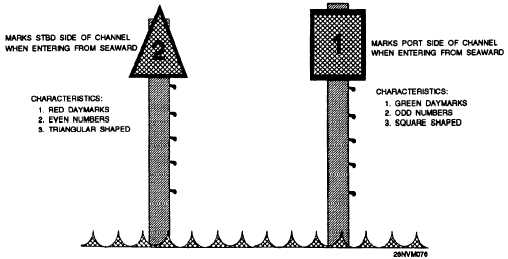| |
Types of Lights and Light Structures, Continued
Ranges
continued
For a given range, the true bearing of the range axis will be listed in
column 2 of the Light List immediately below the name of the rear
range. As you approach this range and line up the lights and daymarks
as shown in figure 4-6, you are on channel centerline. In figure 4-6, if
the channel axis is listed as 020° and your ship has the markers in line,
your gyro compass should read 020°. If it does not, the difference in
degrees will equal your gyro error.
While the range markers discussed above are precisely positioned to
mark a channel, you should also be aware that natural ranges are also
used on occasion. For example, a tank and a radio antenna, when
observed in line, may form a natural range marking safe water.
Directional
Lights
In certain situations where range lights are desirable but not practicable
to build, a less effective, but generally accepted substitute known as a
directional light is used. A directional light illuminates a sector or
displays a very narrow angle light beam for a ship to follow. In some
cases, three colors of light are used. A high intensity white light will be
bordered on each side with a green and red light. The green sector will
mark the side of the channel with green buoys, and the red sector marks
the side with red buoys. Remaining in the white sector keeps you in the
channel.
Figure 4-7. Daymarks.
4-17
|

